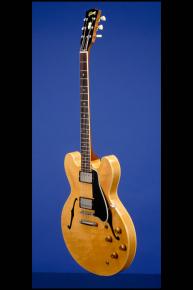The Rarest of the Rare…
One of just seventy-one 1959 Natural ES-335TDs (shipped in mid September).This fifty-year-old beauty weighs just 7.80 lbs. and has a nice, fat nut width of just under 1 11/16 inches and a standard Gibson scale length of 24 3/4 inches. Amazing two-piece top which has both 'flame' and 'quilt', laminated maple body with single binding on the top and back and semi-solid construction with maple central block. One-piece mahogany neck with an extremely comfortable medium neck profile, not as fat as a typical '59 but certainly not 'skinny' like a '60. Bound Brazilian rosewood fretboard with 22 original jumbo frets and inlaid pearl dot position markers. Headstock with inlaid pearl "Gibson" logo and pearl crown inlay. Individual 'single-line' Kluson Deluxe tuners with single-ring Keystone plastic buttons and "D-169400 PATENT NO." stamped on the inside. Two "double-black" PAF humbucker pickups with black plastic surrounds and really strong outputs of 8.49k and 8.74k. Each pickup has a small rectangular black "Patent Applied For" label on the underside. The pickup "rings" are the original black plastic stamped underneath "MR 491" and "M-69 7" (neck pickup) and "MR 490" and "M-69 8" (bridge pickup). "Long" five-layer (black/white/black/white/black) plastic pickguard extending below the bridge. Four controls (two volume, two tone) plus three-way selector switch for pickup selection, all on lower treble bout. Gold plastic bell-shaped "Bell" knobs. ABR-1 Tune-O-Matic non-retainer bridge with metal saddles and separate stud tailpiece. With the original Gibson orange oval label inside the bass 'f'-hole, the style ("ES-335/T") written in black ink and the serial number ("A 31251") stamped in black. Inside the treble 'f'-hole the FON (factory order number) "S 9204 31" is stamped in dark blue. This extremely beautiful instrument came from the original family to the present owner and is in near mint (9.25) condition. The only exceptions to perfection are as follows: The tuner-tips (which had crystalized) have been replaced with 'Uncle Lou' premium tips. There is a small amount of belt buckle wear on the back including a few very small areas of surface loss - the largest being 5/16 x 1/4 inch. There are two tiny areas of surface loss on the top, one on the edge of the treble horn, the other just by the bridge pickup volume control. A few tiny and insignificant other surface marks on the back, top and sides and exactly the correct amount of fine checking that one would expect. There is a tiny surface only crack on the top either side of the jack input which extends 1/4 inch either side. The original frets have been dressed and there is plenty of life left in them. The back of the neck has two areas of varnish (playing) wear and the headstock edges show some typical playing wear. A truly spectacular example of the rarest of all the 335's. Quite simply the best we have ever seen. Complete with the original "Tune-O-Matic Bridge" instructions and the original "Humbucking Pickup Adjustments" sheet, both in the original manilla envelope. Housed in the original Gibson four-latch brown hardshell case with pink plush lining (9.25).
The original price in September 1959 was $295.00 - $15.50 more than the Sunburst model… and the case was $47
The serial number of this guitar is "A 31251". From Duchossoir's book on Guitar Identification we know that serial number "A 31281" (an ES-355T) was shipped on October 1st, 1959. We also know from the same source that serial number "A 30569" was shipped on July 3rd, 1959. The original production run of 'Natural' ES-335's was as follows: 1958 - 50 guitars; 1959: 71 guitars; 1960: 88 guitars, making a total of just 209 instruments.
Postscript: We have just had confirmation from our friends at the Gibson archive who have confirmed to us that serial numbers "A-31247" through A-31251" were all listed as natural finished ES-335 models which were all shipped in sometime between the 14th and 30th of September 1959.
"Introduced in 1958, the ES-335T (originally no final D) truly ranks among the all-time Gibson classics, not only because of its enduring popularity but also because of its semi-solid construction which pioneered a new style of electrics" (A.R. Duchossoir, Gibson Electrics -- The Classic Years, p. 231).
"There were indeed a number of firsts in the early days of the electric guitar, but in retrospect only few of them can be considered as true milestones. The double cutaway thinline pioneered by Gibson in 1958 genuinely rank amongst the great original designs. Their graceful shape was truly innovative at the time and spawned several imitations such as Gretsch's revamped Chet Atkins series or the Guild Starfire. But perhaps the most important hallmark of the new thinline was their semi-solid construction. Indeed Gibson's prime objective was to design an instrument that would combine the advantages of both solid and hollow body electrics and therefore appeal to a variety of players, regardless of their musical style" (A.R. Duchossoir, Gibson Electrics-Classic Years, p.77).
Translate:










